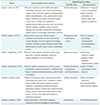1. Carter CE, Veale BL. Digital radiography and PACS. St. Louis (MO): Mosby;2008.
2. Fitzgerald-Hayes M, Reichsman F. DNA and biotechnology. Boston (MA): Elsevier;2010.
3. Smallwood RF. Managing electronic records: Methods, best practices, and technologies. Hoboken (NJ): John Wiley & Sons;2013.
4. Ballweg R, Brown D, Vetrosky DT, Ritsema TS. Physician assistant: a guide to clinical practice. Philadelphia (PA): Elsevier;2017.
5. O'Carroll PW, Ripp LH, Yasnoff WA, Ward ME, Martin EL. Public health informatics and information systems. New York (NY): Springer;2003.
6. Masic I. The history and new trends of medical informatics. Donald School J Ultrasound Obstet Gynecol. 2013; 7(3):301–302.

7. Bronzino JD. Medical devices and systems. Boca Raton (FL): CRC Press;2006.
8. Scaletti A. Evaluating investments in health care systems: health technology assessment. Heidelberg: Springer;2014.
9. Hayes BM, Aspray W. Health informatics: a patient-centered approach to diabetes. Cambridge (MA): MIT Press;2010.
10. Deng H, Wang J, Liu X, Liu B, Lei J. Evaluating the outcomes of medical informatics development as a discipline in China: a publication perspective. Comput Methods Programs Biomed. 2018; 164:75–85.

11. Kruse CS, Stein A, Thomas H, Kaur H. The use of electronic health records to support population health: a systematic review of the literature. J Med Syst. 2018; 42(11):214.

12. Ross T. A survival guide for health research methods. Maidenhead, UK: McGraw-Hill Education;2012.
13. Walker E, Hernandez AV, Kattan MW. Meta-analysis: its strengths and limitations. Cleve Clin J Med. 2008; 75(6):431–439.

14. Stegenga J. Is meta-analysis the platinum standard of evidence? Stud Hist Philos Biol Biomed Sci. 2011; 42(4):497–507.

15. Watanabe M. Going multidisciplinary. Nature. 2003; 425(6957):542–543.

16. Chen C. Mapping scientific frontiers: the quest for knowledge visualization. London: Springer;2013.
17. Xu G, Zhang Y, Li L. Web mining and social networking: techniques and applications. New York (NY): Springer;2011.
18. Gonzalez GH, Tahsin T, Goodale BC, Greene AC, Greene CS. Recent advances and emerging applications in text and data mining for biomedical discovery. Brief Bioinform. 2016; 17(1):33–42.

19. Aggarwal CC, Wang H. Text mining in social networks. In : Aggarwal CC, editor. Social network data analytics. Boston (MA): Springer;2011. p. 353–378.
20. Bornmann L, Haunschild R, Hug SE. Visualizing the context of citations referencing papers published by Eugene Garfield: a new type of keyword co-occurrence analysis. Scientometrics. 2018; 114(2):427–437.

21. Khokhar D. Gephi cookbook. Birmingham, UK: Packt Publishing Ltd.;2015.
22. Parente ST, McCullough JS. Health information technology and patient safety: evidence from panel data. Health Aff (Millwood). 2009; 28(2):357–360.

23. Alotaibi YK, Federico F. The impact of health information technology on patient safety. Saudi Med J. 2017; 38(12):1173–1180.

24. Kaelber DC, Bates DW. Health information exchange and patient safety. J Biomed Inform. 2007; 40:6 Suppl. S40–S45.

25. Kawamoto K, Houlihan CA, Balas EA, Lobach DF. Improving clinical practice using clinical decision support systems: a systematic review of trials to identify features critical to success. BMJ. 2005; 330(7494):765.

26. Sim I, Gorman P, Greenes RA, Haynes RB, Kaplan B, Lehmann H, et al. Clinical decision support systems for the practice of evidence-based medicine. J Am Med Inform Assoc. 2001; 8(6):527–534.

27. Bates DW, Cohen M, Leape LL, Overhage JM, Shabot MM, Sheridan T. Reducing the frequency of errors in medicine using information technology. J Am Med Inform Assoc. 2001; 8(4):299–308.

28. Bauchner H, Simpson L, Chessare J. Changing physician behaviour. Arch Dis Child. 2001; 84(6):459–462.

29. Shiffman RN, Liaw Y, Brandt CA, Corb GJ. Computer-based guideline implementation systems: a systematic review of functionality and effectiveness. J Am Med Inform Assoc. 1999; 6(2):104–114.

30. Purcell GP, Wilson P, Delamothe T. The quality of health information on the internet. BMJ. 2002; 324(7337):557–558.

31. Gagliardi A, Jadad AR. Examination of instruments used to rate quality of health information on the internet: chronicle of a voyage with an unclear destination. BMJ. 2002; 324(7337):569–573.

32. Skiba DJ. Informatics competencies for nurses revisited. Nurs Educ Perspect. 2016; 37(6):365–367.

33. Graves JR, Corcoran S. The study of nursing informatics. Image J Nurs Sch. 1989; 21(4):227–231.

34. Bickley L, Szilagyi PG. Bates' guide to physical examination and history-taking. Philadelphia (PA): Lippincott Williams & Wilkins;2012.
35. Hersh W. Medical informatics education: an alternative pathway for training informationists. J Med Libr Assoc. 2002; 90(1):76–79.
36. Norris AC. Current trends and challenges in health informatics. Health Informatics J. 2002; 8(4):205–213.

37. Gagnon MP, Ngangue P, Payne-Gagnon J, Desmartis M. m-Health adoption by healthcare professionals: a systematic review. J Am Med Inform Assoc. 2016; 23(1):212–220.

38. Wilkowska W, Ziefle M. Privacy and data security in ehealth: requirements from the user's perspective. Health Informatics J. 2012; 18(3):191–201.

39. Pilemalm S, Timpka T. Third generation participatory design in health informatics: making user participation applicable to large-scale information system projects. J Biomed Inform. 2008; 41(2):327–339.

40. Kvedar J, Coye MJ, Everett W. Connected health: a review of technologies and strategies to improve patient care with telemedicine and telehealth. Health Aff (Millwood). 2014; 33(2):194–199.

41. Swan M. Health 2050: the realization of personalized medicine through crowdsourcing, the quantified self, and the participatory biocitizen. J Pers Med. 2012; 2(3):93–118.





 PDF
PDF ePub
ePub Citation
Citation Print
Print











 XML Download
XML Download